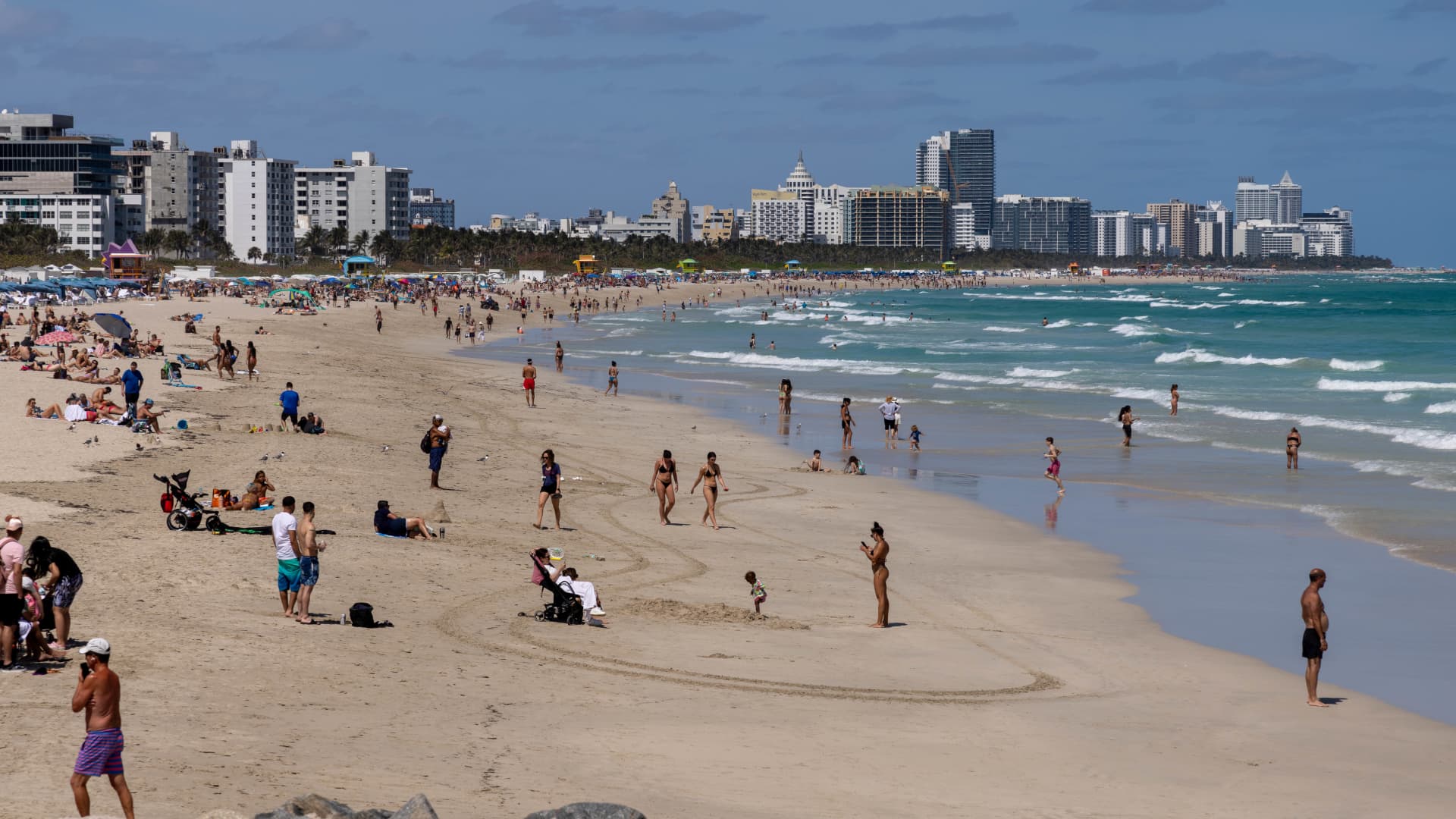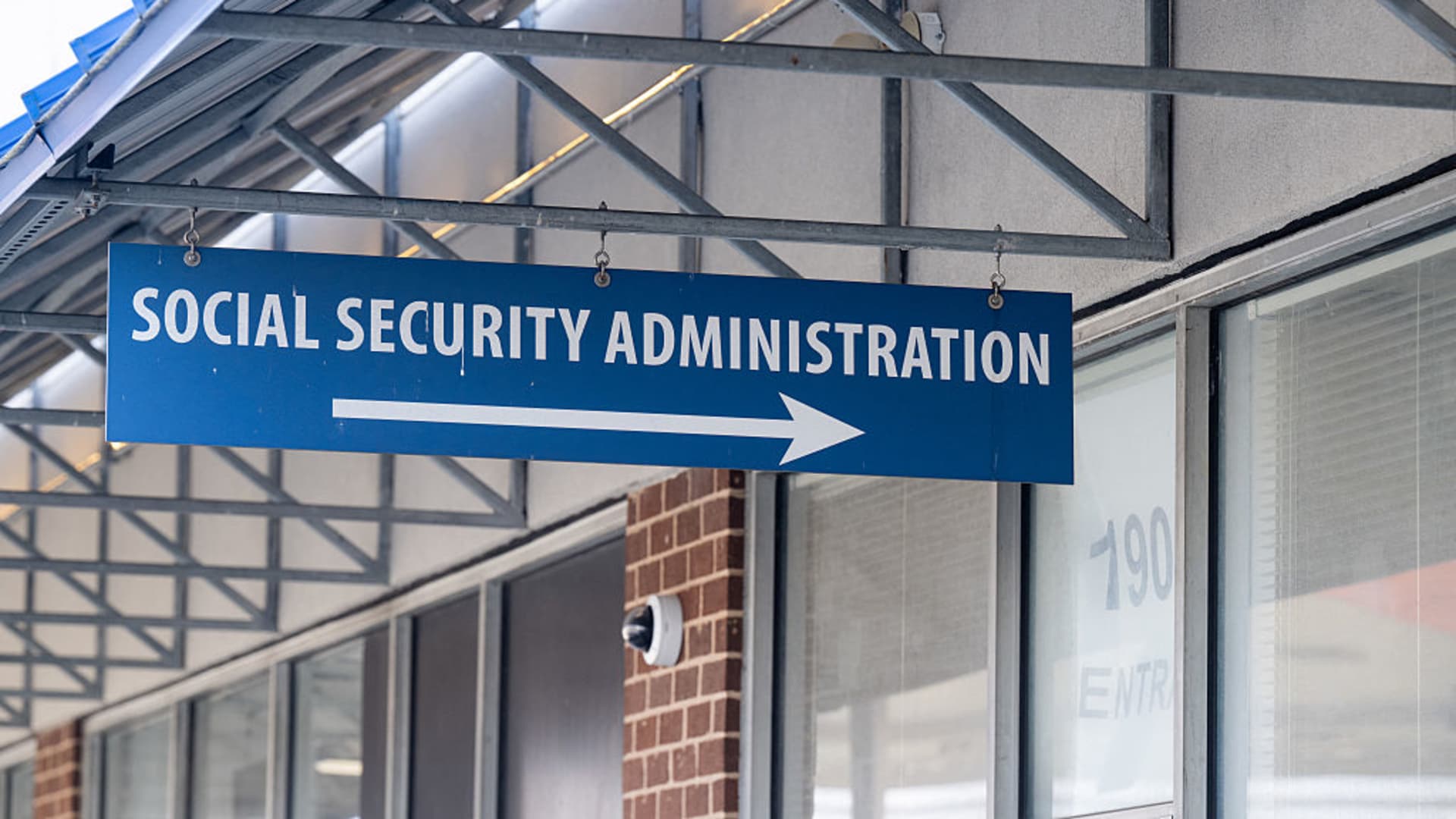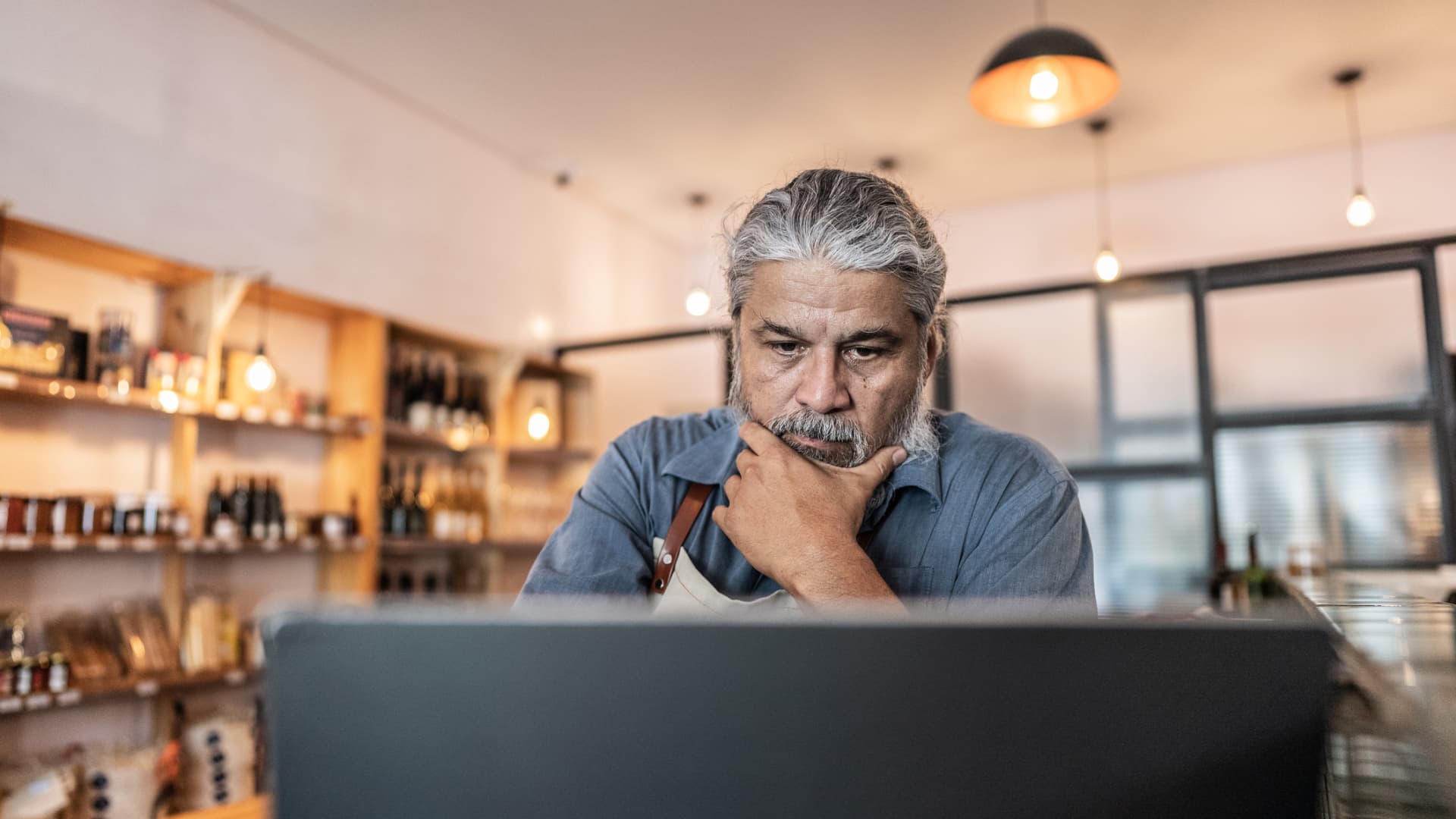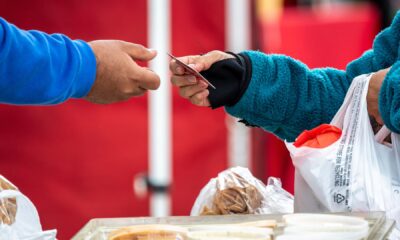Personal Finance
Miami is ‘ground zero’ for climate risk. People move there, build there anyway
Published
11 months agoon

South Pointe Beach in Miami Beach, Florida.
Greg Iacurci
MIAMI — Daniel Habibian worries about climate change.
His clothing boutique in Miami Beach’s iconic South Beach neighborhood sits just a few blocks inland from the Atlantic Ocean.
Rising seas threaten to swallow much of the Miami metro area in the coming decades as the world continues to warm and faraway ice sheets melt. By 2060, about 60% of Miami-Dade County will be submerged, estimates Harold Wanless, a professor of geography and sustainable development at the University of Miami.
Yet people keep moving there. The city’s skyline has grown in tandem.
Miami’s boom runs headlong into a harsh yet inescapable truth: It’s “ground zero for climate change,” said Sonia Brubaker, chief resilience officer for the City of Miami.
Climate risk is “always on our thoughts,” said Habibian, 39, who moved to Miami-Dade County about six years ago.
Daniel Habibian stands outside his store, Studio 26, a clothing boutique in South Beach.
Greg Iacurci
“[Miami] is almost at sea level, so a bit of water can take it underwater,” he told CNBC inside his store, Studio 26.
Outside, sun-kissed tourists and locals trickled by on their way back from the nearby ocean as reggaeton pulsed from flashy convertibles. The March air, a perfect 75 degrees, mixed with a gentle breeze that caressed palm fronds and passersby in a warm embrace.
Such weather is what drew Habibian to the area from New York.
“We like living here,” he said. “So we’ll see what happens.”
More people ‘moving into risky areas’ than leaving
The Miami metro area — including Miami, Fort Lauderdale and West Palm Beach — is a low-lying swath of South Florida that is home to more than 6 million people.
Its urban sprawl juts abruptly from the Atlantic shoreline like a vertical spike of glass, metal and concrete.
Construction volume in the greater Miami metro area hit $27.4 billion in 2023, up 73% from $15.8 billion in 2014, according to an analysis by Cumming Group, a project management and cost consulting firm.
It projects that those values, which are adjusted for inflation, will rise to about $29 billion in 2024 and 2025.
The Miami area population has also ballooned, growing by more than 660,000 people from 2010 to 2020 — the most of any other Florida metropolis and nearly twice the tally of No. 2 Tampa-St. Petersburg, according to the Florida Department of Transportation.
The Bentley Residence condominium complex, center, under construction in Miami, Florida, in September 2022.
Saul Martinez/Bloomberg via Getty Images
The trend shows how many Americans are ultimately willing to overlook environmental risks, even though most acknowledge its presence — a choice that could later devastate them financially.
Across the U.S., people are still moving into areas increasingly prone to natural disasters, according to Andrew Rumbach, a senior fellow at the Urban Institute.
“We have a lot more people moving into risky areas than moving out, which is kind of counterintuitive,” Rumbach said.
The contradictory forces at play in Miami foreshadow the financial hardship many other Americans will likely face, too.
Rising seas and a sinking city
A flooded street in Miami after a tropical storm in June 2022. The system dumped at least six to 10 inches of rain in the area.
Joe Raedle | Getty Images News | Getty Images
Miami’s average elevation is six feet — the same amount of sea-level rise expected in Southeast Florida by the end of the century. The ocean has already risen by about six inches since 2000.
The city is simultaneously sinking. It sits on porous limestone rock, which some engineers have likened to Swiss cheese; in other words, water can easily seep from underground.
These dynamics exacerbate flooding from rising seas, storm surge, torrential rains and so-called “king tides,” which are periodic exceptionally high tides. The frequency of flooding from high tides — known as “sunny day” flooding — is up over 400% in Miami Beach since 2006.
Researchers at the Organisation for Economic Co-operation and Development listed Miami as one of the 10 most vulnerable cities worldwide relative to the number of people at risk of coastal inundation. It’s the most vulnerable when judged by the total value of assets such as buildings and infrastructure at risk.
Meanwhile, Miami residents are also confronted by more extreme heat and intensifying storms such as hurricanes, experts said.
Volunteers clear debris from a Florida Keys home damaged by a six-foot storm surge during Hurricane Irma.
Al Diaz/Miami Herald/Tribune News Service via Getty Images
The financial threats of such climate disasters are numerous: property damage, higher insurance premiums and medical bills, lost earnings, falling real estate values, declining tourism, forgone business profits and displacement costs such as temporary housing or relocation, among others.
Despite that risk, 66% of Miami-Dade County residents said they’d never leave, according to a study published in the journal Climate Risk Management.
It is not that they deny climate change: More than three-quarters, 77%, of Miami-Dade County residents say global warming is happening, 5 percentage points above the 72% national average, according to a poll by Yale University’s School of the Environment.
More from Personal Finance:
Why climate change may cost you big bucks
What the SEC vote on climate disclosures means for investors
8 easy — and cheap — ways to cut your carbon emissions
“I do believe we’re going to be in danger of losing land in the near future — maybe 50 years, 100 years — because of sea-level rise,” said Steven Bustamante, 32, a Miami Beach resident.
But it’s not something that would push him to leave.
Bustamante, who works at a market in South Beach, has lived here all his life and loves the subtropical climate.
In multiple street interviews CNBC conducted with Miami residents, weather was almost universally cited as the top draw.
“I wouldn’t leave,” Bustamante said. “I wouldn’t leave for anything.”
CEO says Miami is the ‘future of America’
Jeff Greenberg | Universal Images Group | Getty Images
The “breakneck pace” at which high-rise condos, hotels and offices have popped up has quickly made Miami’s skyline “one of the largest and tallest in the country,” according to Cumming Group.
Miami still has the feel of a city under construction as developers scramble to meet housing demand. Cranes pepper the horizon next to the hollow husks of future high rises.
The City of Miami issued roughly 10 permits to build new residential and mixed-use buildings in 2014, according to a CNBC analysis of city data. By 2019, that figure had ballooned to more than 150 — an increase of well over 1,000%.
“There’s been a fairly strong development boom for quite some time,” said David Arditi, a founding partner of Aria Development Group, a residential real estate developer.
The Covid-19 pandemic “turbocharged” the city’s growth, said Arditi, who leads Aria’s Miami office.
The number of people who moved to the Miami metro area increased by nearly 60% between 2019 and 2022, more than any other major U.S. metro hub, according to the National Association of Realtors.
Office workers in the financial district of downtown Miami, Florida.
Saul Martinez/Bloomberg via Getty Images
With the freedom to work from anywhere, many people sought out better quality of life, including warm weather, relatively low taxes and ample job opportunity, Arditi said from Aria’s sales office for 2200 Brickell, a new residential building slated for completion around early 2026. Half of its 105 available condos are already sold. Prices start at $1 million.
A large share of recent migration is from California, New York and New Jersey, relatively high-tax states, according to a Miami Realtors analysis.
“Climate is only one thing people are thinking about when they’re making these decisions,” said Rumbach, of the Urban Institute.
In hot spots such as Miami, shorter-term interests can trump climate risk, he said.
Billionaires such as Amazon founder Jeff Bezos and Goldman Sachs Managing Director Douglas Sacks have relocated to Miami in recent years. Companies such as Citadel, a financial firm, and SH Hotels & Resorts also recently moved their global headquarters to the city, known as a “gateway” to Latin America and the Caribbean.
Ken Griffin, Citadel’s billionaire CEO, told Bloomberg News in November that Miami “represents the future of America.”
Such company and worker relocations have helped boost the local economy, said Brubaker, the city official.
Miami-Dade County’s 1.6% unemployment rate in February 2024 is near its lowest on record and is substantially lower than the national average of 3.9% that month.
“And you know, people get to enjoy year-round, beautiful weather,” Brubaker added. “Unless there’s a disaster.”
‘I hope the city doesn’t disappear’
Contractors work at a Miami office tower under construction in September 2022.
Saul Martinez/Bloomberg via Getty Images
Downtown Miami will soon host the tallest residential building south of New York City — the Waldorf Astoria Hotel and Residences, a 100-story monolith under construction on the shore of Biscayne Bay. Miami Worldcenter, a forthcoming 27-acre mixed-use complex, will be the second-largest urban development in the U.S. behind New York City’s Hudson Yards.
Developers and city officials tell CNBC they think a booming city can continue to thrive alongside climate change.
They tout Miami’s stringent building codes and infrastructure enhancements — such as higher elevation and more permeable ground for new construction, and higher roads and sea walls — as evidence of its resilience.
The City of Miami has a $400 million bond dedicated to investing in climate resilience projects.
“The city actively plans for it,” said Brubaker, who became the City of Miami’s chief resilience officer in 2022. “There’s a lot of preparation going into this.”
South Pointe Park in the City of Miami Beach is a green buffer between the water and the South of Fifth neighborhood.
Greg Iacurci
But some scientists and other experts see a misalignment when it comes to developers’ interests: Are they capitalizing on today’s hot real estate market with short-term investments and planning to offload properties before climate change threatens their long-term value? In that case, condo owners and other buyers may be left holding the bag.
From start to finish, Aria typically exits its real-estate projects after about five years, for example, said Arditi. It depends on the building — condominium projects may be on the short end of that range, while multifamily rentals are generally longer-term, he said.
“We try to be smart about it, try to be proactive as best we can,” Arditi said of climate risk. “It’s clearly top of mind.”
“But I hope the city doesn’t disappear anytime soon,” he added.
Rain storms can induce ‘trauma’
A woman walks in flooded water during a heavy rainfall in Miami on May 26, 2020.
Chandan Khanna | Afp | Getty Images
The risks of climate change are already a part of life in Miami.
“Every time it rains, I basically suffer a bit of a trauma,” said Dion Williams, a clothing designer with a storefront on Collins Avenue in South Beach, close to Habibian’s shop.
Williams moved to Miami eight years ago. His business, Dion Atelier, is on the ground floor a few streets from the ocean.
During big rain storms “the swell comes up, and the first thing that happens is the whole entire floor terrace floods,” said the proprietor, standing amid neatly styled displays and mannequins draped in high-end fashion.
Sometimes, the flooding is so bad it’s “almost like a lake,” Williams said.
He pointed out sections of the baseboard that had to be ripped out and replaced. Just an inch of flood water can cause $25,000 of property damage, according to the Federal Emergency Management Agency.
Now, as a precaution, Williams covers his merchandise in plastic when it rains.

About 70% of the 597 Miami-Dade County residents polled for a study published in the Climate Risk Management journal experienced rainfall-related flooding between 2017 and 2022, about 60% were affected by floodwater from hurricanes and tropical storms, and 16% were affected by tidal flooding.
The financial impacts were broad. Among them, 34% couldn’t commute to work, a dynamic that can reduce household earnings, experts said.
About 22% said their property and car insurance rates increased. Average property-casualty insurance premiums in the Sunshine State have risen to more than $4,200 a year, triple the national average, according to the Insurance Information Institute.
When underground water can be lethal
Water can also pose more insidious risks than flooding.
Saltwater intrusion is one dangerous example, said Todd Crowl, director of the Florida International University Institute of Environment and a science advisor for the mayor of Miami-Dade County.
This happens when salt water moves inland into freshwater reserves. That threatens drinking water and coastal infrastructure, since salt water can eat away certain building materials, Crowl said.
“And you know, people get to enjoy year-round, beautiful weather — unless there’s a disaster.”
Sonia Brubaker
chief resilience officer for the City of Miami
Saltwater intrusion is being exacerbated by Miami’s growth.
Inhabitants are drawing increasing amounts of water from freshwater aquifers. The Everglades, which replenishes local aquifers, has lost more than 70% of its water flow over the years, for example. Meanwhile, rising seas push salt water further inland.
It’s a “3,000-pound gorilla in the room,” Crowl said.
Saltwater intrusion was “almost certainly” a contributing factor in the 2021 collapse of a condo building in nearby Surfside, Florida, that killed 98 people, he said. An investigation into the cause of the collapse is ongoing.
“We’re losing a [water] pressure battle,” Crowl said. “We can’t build these big buildings on the coast if they’ll start getting inundated with salt water under their footings.”
The rich can absorb financial loss …
Florida is also the hurricane capital of the country.
Hurricanes can bring about a kind of “urban renewal,” meteorologist Erik Salna said from the control room for the Wall of Wind, a facility that simulates the turbulent conditions of a Category 5 hurricane.
As older, outdated dwellings get damaged, destroyed or blown away, new and more expensive buildings remain, he explained.
Twelve massive intake fans are stacked in an open-air hangar adjacent to the Wall of Wind control room. Each is roughly six feet in diameter and weighs 15,000 pounds, about the weight of a mature African elephant. Together, they help generate top wind speeds of 157 miles per hour.
Erik Salna at the Wall of Wind facility, which simulates conditions of a Category 5 hurricane.
Greg Iacurci
A bigger wind facility in development will create maximum speeds of 200 miles an hour. The so-called “Category 6” project is a recognition of a future with more-intense storms.
The financial burden of hurricanes falls hardest on lower-income households, according to researchers at the University of Pennsylvania.
“If you’re a high-wealth individual, it doesn’t matter,” said Salna, the associate director for education and outreach at the International Hurricane Research Center.
“They’re millionaires,” he said. “They can handle that loss.”
… but they’re increasing their exposure to risk
Mansions along Biscayne Bay. As the area has been developed, the number of mangroves has significantly declined.
Greg Iacurci
Indeed, the ultrarich have flocked to South Florida, driving a mansion boom.
Many wealthy homeowners have increased their climate risk by cutting mangroves on their property — often to create oceanfront views and make room for boat slips, said Chris Baraloto, who heads the Institute of Environment’s land and biodiversity unit.
Mangroves are dense, coastal shrubs and trees that grow in the tropics and subtropics. They’re ecological wonders, forming a natural, frontline defense against flooding and storm surge, and helping dissipate wave and wind energy.
Baraloto estimates just 2% of mangroves are left in the peninsular City of Miami.
Todd Crowl and Rita Teutonico of Florida International University look toward Biscayne Bay. At left is one of the City of Miami’s few remaining stands of mangroves.
Greg Iacurci
“This is the view everyone wants,” he said from behind the wheel of a golf cart, as we rolled toward a thin shoreline outcropping of Bermuda grass in The Kampong, a botanical garden in Coconut Grove. A palm tree stood at its point and a sweeping vista of Biscayne Bay lay beyond.
Juxtaposed at left was one of the last remaining patches of mangroves in the urban Miami area, a living memorial to a once-thriving population.
Mansions flanked it on each side.
Trying to make Miami livable
Meanwhile, Miami Beach recently planted 680 mangroves in Brittany Bay Park, an effort to create a “living shoreline,” said Amy Knowles, the municipality’s chief resilience officer.
Knowles, also the director of environment and sustainability, was strolling the boardwalk of South Pointe Park, a 19-acre green buffer built between the water and the South of Fifth neighborhood.
“We’re aware of the science; we’re aware of the risks,” Knowles said.
But it’s not as if officials can just move Southeast Florida, she added.
“It’s very hard for residents, businesses, people to just kind of forget the beauty and the history and acknowledge the risk and maybe just leave,” Knowles said.
Amy Knowles, chief resilience officer and director of environment and sustainability for the City of Miami Beach
Greg Iacurci
Miami-Dade County’s resilience plan — Resilient305, a reference to its area code — aims to help the area both “survive” and “thrive” despite climate risk.
Knowles and Brubaker of the City of Miami cited a litany of projects planned or underway: Public infrastructure improvements such as elevated roads, upgraded storm-water and sewer systems and higher seawalls; and urban redesign with more green space and tree canopy cover, for example. Salinity control structures have been installed near major canals to separate fresh and saltwater, to prevent saltwater intrusion.
Miami Beach introduced a grant program that offers up to $20,000 per household to incentivize homeowners to reduce their flood risk, Knowles said.
Brittany Bay Park, City of Miami Beach.
City of Miami Beach
Officials’ efforts appear to have borne some fruit. For example, the Sunset Harbour neighborhood has experienced about 175 fewer sunny-day flood events after a 2017 project that raised streets two or more feet and added stronger storm-water pumps, Knowles said.
While such resilience efforts are helpful, Crowl, the Institute of Environment director, worries about the area’s livability a few decades from now.
“This gets worse and worse and worse and worse,” he said. “That’s the rub. I think it’s kind of getting close to being too late.”
In this new series, CNBC will examine what climate change means for your money, from retirement savings to insurance costs to career outlook.
Has climate change left you with bigger or new bills? Tell us about your experience by emailing me at [email protected].
You may like
Personal Finance
Disability advocates sue Social Security and DOGE to stop service cuts
Published
17 hours agoon
April 3, 2025
A Social Security Administration (SSA) office in Washington, DC, March 26, 2025.
Saul Loeb | Afp | Getty Images
A group of disability advocates filed a federal lawsuit against the Social Security Administration and the so-called Department of Government Efficiency on Wednesday aimed at stopping cuts to the agency’s services.
Recent changes at the Social Security Administration under DOGE — including staff reductions, the elimination of certain offices and new requirements to seek in-person services — have made it more difficult for individuals with disabilities and older adults to access benefits, the lawsuit argues.
The complaint was filed in the U.S. District Court for the District of Columbia.
The plaintiffs include the National Federation of the Blind, the American Association of People with Disabilities, Deaf Equality, the National Committee to Preserve Social Security and Medicare, the Massachusetts Senior Action Council and individual beneficiaries.
“The defendants’ actions are an unprecedented and unconstitutional assault on Social Security benefits, concealed beneath the hollow pretense of bureaucratic ‘reform,'” the complaint states.
In nine weeks, the new administration has “upended” the agency with “sweeping and destabilizing policy changes,” the plaintiffs claim, that have shifted agency functions to local offices while slashing telephone services.
More from Personal Finance:
Trump administration loses appeal of DOGE Social Security restraining order
Social Security changes may impact service, benefit payments
Trump pick to lead Social Security faces questions on DOGE
“The result is a systematic dismantling of SSA’s core functions, leaving millions of beneficiaries without the essential benefits they are legally entitled to,” the lawsuit complaint states.
The “mass restructuring” of the agency is unlawful and violates the Rehabilitation Act and the Administrative Procedure Act, the lawsuit argues. The changes also violate multiple constitutional provisions, including the First Amendment right to petition the government for redress of grievances, according to the plaintiffs.
With 1.1 million disability claims pending, the recent actions could also be life threatening to individuals who are dying or going bankrupt while waiting for decisions, they allege.
The Social Security Administration did not respond to CNBC’s request for comment.
“President Trump has made it clear he is committed to making the federal government more efficient,” White House spokesperson Liz Huston said in an email statement. “He has the authority to manage agency restructuring and workforce reductions, and the administration’s actions are fully compliant with the law.”
Lawsuit alleges reform is ‘administrative vandalism’
People hold signs during a protest against cuts made by U.S. President Donald Trump’s administration to the Social Security Administration, in White Plains, New York, U.S., March 22, 2025.
Nathan Layne | Reuters
The Social Security Administration sends monthly checks to around 73 million Social Security and Supplemental Security Income beneficiaries.
DOGE, which is not an official government entity, has been tasked with cutting “waste, fraud and abuse” within the federal government. President Donald Trump issued an executive order creating DOGE on Jan. 20, the same day he was inaugurated.
Since then, the Social Security Administration has cut 7,000 employee positions and closed the Office of Civil Rights and Equal Opportunity and the Office of Transformation. The Office of Civil Rights and Equal Opportunity handled the agency’s equal employment opportunity and civil rights programs. The Office of Transformation was responsible for coordinating customer service-related initiatives like adding the ability to use digital signatures and electronic documents.
The Social Security Administration has also changed its identity proofing policies for claiming benefits and changing direct deposit information that is expected to require more individuals to visit the agency’s offices in person.
The agency has updated its policy, allowing individuals applying for Social Security Disability Insurance, Medicare, or Supplemental Security Income who cannot use a personal my Social Security account to complete their claim entirely over the telephone, starting April 14.
The reforms amount to the dismantling of “core functions of SSA, abandoning millions of Americans to poverty and indignity,” according to the plaintiffs’ complaint.
“What the defendants frame as ‘reform’ is, in truth, administrative vandalism,” the lawsuit states.
Beneficiaries face long waits, overpayment issues
The plaintiffs include seven individuals whose experiences, including long customer service waits and, in some cases, demands to repay large sums to the Social Security Administration, are detailed in the complaint.
One plaintiff, Treva Olivero, who has been legally blind since birth, was informed in March 2024 that she had been overpaid Social Security disability insurance benefits for five or six years, prompting the agency to demand she repay more than $100,000, according to the complaint.
Olivero’s Medicaid coverage was also terminated soon after, which left her without income and health coverage. She has since been in an “ongoing struggle” to have her disability benefits reinstated, while also facing almost $80,000 in medical debt, according to the complaint.

Another plaintiff, Merry Schoch, who received Social Security disability insurance for many years, returned to work to help pay for large medical bills after she was hit by a waste management truck in 2022. She reported her income to the Social Security Administration, and the agency made no changes to her benefit payments, according to the complaint.
Two years later, Schoch stopped working and reported her unemployment to the Social Security Administration. In August 2024, the agency then terminated her benefits and informed Schoch that she owed $30,000 for the disability benefit payments she received while working full time, according to the complaint.
Last September, Schoch was informed she could reapply for benefits. However, she has since struggled to get in touch with the agency over the phone, online and in person.
Both Olivero and Schoch are members of the National Federation of the Blind, which is also a plaintiff.
The plaintiffs want the court to reverse the Social Security Administration’s recent reforms, including staff reductions, closures of certain offices and policies requiring in-person appointments.
Personal Finance
Amid trade turmoil, ‘you do not want to time the market’
Published
21 hours agoon
April 3, 2025

As President Donald Trump rolls out sweeping new tariffs on goods imported into the United States, Americans are growing increasingly pessimistic about their financial fate.
Consumers worry that the duties will cause inflation to flare up again, while investors fear that higher prices will mean lower profits and more pain for the battered stock market.
As of Thursday morning, futures tied to the Dow Jones Industrial Average were down 1,200 points, or 2.8%. S&P 500 futures sank 3.4%, and Nasdaq-100 futures lost 4%.
But sharp drops — or sudden spikes — in the market are to be expected, according to Jean Chatzky, CEO of HerMoney.com and host of the podcast HerMoney with Jean Chatzky.
“With these volatile markets, you do not want to time the market,” she said of the old adage. “Timing the market doesn’t work — it’s time in the market.”
More from Personal Finance:
Tariffs are ‘lose-lose’ for U.S. jobs and industry
Why uncertainty makes the stock market go haywire
Americans are suffering from ‘sticker shock’ — how to adjust
Trade tensions, inflation and concerns about a possible recession have undermined consumer confidence across the board, several studies show.
Still, it’s normal for most Americans to feel unnerved during heightened volatility, Chatzky said.
“There’s very little doubt that consumers are feeling nervous, maybe more nervous than we’ve felt in quite some time,” she said.
Committing to setting money aside in a high-yield savings account, whether by scaling back on dining out or rideshare expenses, will help regain some financial control, Chatzky said.
Top-yielding online savings accounts currently pay 4.4%, on average, well beyond the savings account rates at some of the largest retail banks, which average just 0.41%.
“Taking action is the best way to feel more resilient,” she said.
It’s understandable why some may be hesitant to continue investing, however, when you are investing for the long term, a down market is an opportunity for dollar-cost averaging, which helps smooth out price fluctuations in the market, Chatzky said.
This is also a good time to check your investments to make sure you are still allocated properly and rebalance as needed, so you are not taking on more risk that you are comfortable with, she added.
Timing the market is a losing bet
Talk yourself down from making any sudden financial moves, Chatzky advised.
Trying to time the market is almost always a bad idea, other financial experts also say. That’s because it’s impossible to know when good and bad days will happen.
For example, the 10 best trading days by percentage gain for the S&P 500 over the past three decades all occurred during recessions, often in close proximity to the worst days, according to a Wells Fargo analysis published last year.
And, although stocks go up and down, the S&P 500 index has an average annualized return of around 10% over the past few decades.
Personal Finance
How to file for a free tax extension if you can’t make April 15 deadline
Published
23 hours agoon
April 3, 2025
Galina Zhigalova | Moment | Getty Images
If you can’t file your taxes by the April 15 deadline, there’s a free, easy way to submit a federal tax extension online, experts say.
Nearly 1 in 3 American admit that they procrastinate when it comes filing their taxes, according to a January survey of more than 1,000 U.S. filers from IPX1031, an investment property exchange service. In addition, about 25% do not feel prepared to file their taxes, the survey found.
As of March 21, the IRS received roughly 80 million individual returns of the 140 million expected this filing season, the agency’s latest reporting shows.
More from Personal Finance:
How to spring-clean your finances. It can ‘make you feel more secure,’ advisor says
Tariffs will likely raise much less money than White House projects: economists
The federal government is phasing out paper checks. Here’s who will be affected
Many natural disaster victims have an automatic tax extension, which varies by jurisdiction. Military members serving in a combat zone also have more time to file.
However, the federal tax deadline for the majority of taxpayers is April 15. It’s possible to push that due date to Oct. 15 by filing for an extension.
But “it’s an extension to file, not an extension to pay,” said Jo Anna Fellon, managing director at financial services firm CBIZ.
“It’s an extension to file, not an extension to pay.”
After the tax deadline, you will start incurring the failure-to-pay penalty of 0.5% of your unpaid taxes for each month or partial month that your taxes remain unpaid. The failure-to-pay penalty has a maximum charge of 25% of your unpaid taxes.
That’s cheaper than the failure-to-file penalty, which applies when you don’t submit your return by the deadline. The failure-to-file penalty is 5% of unpaid taxes monthly, also limited to 25%.
But you’ll also owe interest on your unpaid balance, which is currently 7% and accrues daily after April 15.
You can estimate your taxes owed by creating a “pro forma return” — or mock version of your filing — using as many tax forms as possible, Fellon said.
The ‘easiest way’ to file an extension
There are a few free options to file a tax extension.
For federal taxes, you can complete Form 4868 and mail it to the IRS. But it’s better to file digitally to avoid processing delays amid the agency’s shrinking workforce, experts say. Paper filing can also increase fraud risk, they say.
The “easiest way” is by choosing “extension” when making a payment for 2024, which automatically submits Form 4868, according to Tommy Lucas, a certified financial planner and enrolled agent at Moisand Fitzgerald Tamayo in Orlando, Florida.
“It takes all of five minutes,” and you can double-check the transaction via your IRS online account, he said.
IRS Direct Pay
Internal Revenue Service
Alternatively, you can file your extension for free online via IRS Free File, a public-private partnership between the IRS and several tax software companies.
For the 2025 season, you can use IRS Free File for returns if your adjusted gross income, or AGI, was $84,000 or less in 2024. But there’s no income limit to file an extension, Lucas said.
Don’t miss these insights from CNBC PRO


China to impose 34% retaliatory tariff on all goods imported from the U.S.

Actively managed ETFs hit $1 trillion

Donald Trump is attacking what made American universities great

New 2023 K-1 instructions stir the CAMT pot for partnerships and corporations

The Essential Practice of Bank and Credit Card Statement Reconciliation

Are American progressives making themselves sad?
Trending
-

 Economics1 week ago
Economics1 week agoYoung Americans are losing confidence in economy, and it shows online
-

 Personal Finance1 week ago
Personal Finance1 week agoStudent loans could be managed by the Small Business Administration
-

 Economics7 days ago
Economics7 days agoPCE inflation February 2025:
-

 Economics1 week ago
Economics1 week agoWhite House denials over the Signal snafu ring hollow
-

 Accounting7 days ago
Accounting7 days agoIRS sets new initiative with banks to uncover fraud
-

 Economics7 days ago
Economics7 days agoConsumer sentiment worsens as inflation fears grow, University of Michigan survey shows
-

 Economics1 week ago
Economics1 week agoTexas troopers are in more and more lethal car chases
-

 Personal Finance1 week ago
Personal Finance1 week agoMillions of student loan borrowers past-due after bills restarted: Fed
